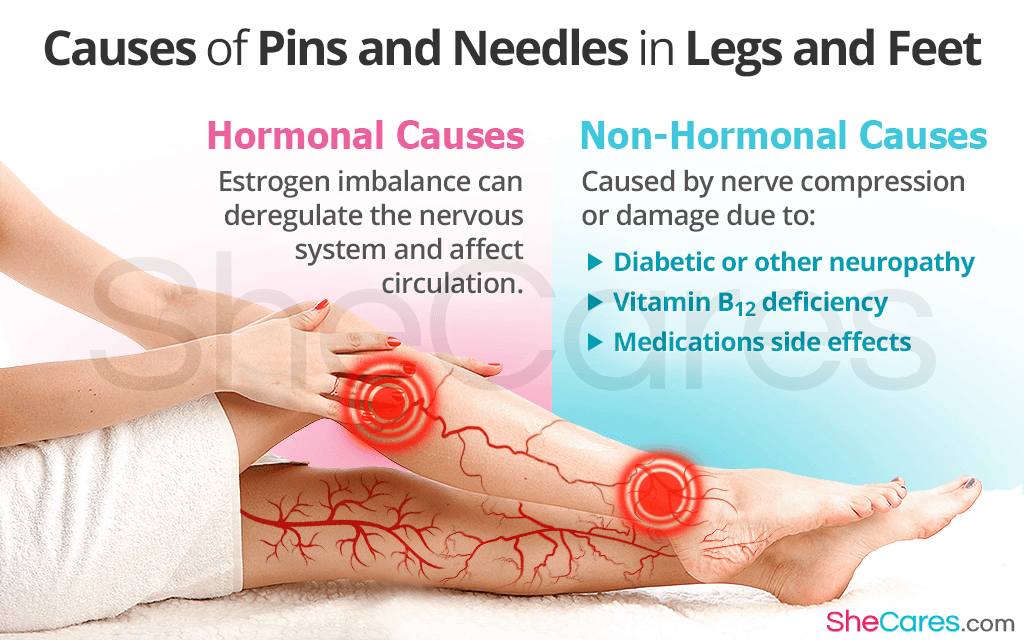Pins and needles in the legs and feet is a relatively well-known and often uncomfortable sensation that many women of various ages experience. Although it may be challenging to pinpoint the exact cause of tingling extremities, there are various management approaches to prevent pins and needles from plaguing women's days.
Keep on reading to learn all about pins and needles in the legs or feet, including what it is, what causes it, and how to properly manage it for long-lasting relief.
About Pins and Needles in Legs
The colloquial term “pins and needles” describes a tingling or prickling sensation in the foot that is usually more uncomfortable and distracting than it is painful. The medical term for pins and needles is paresthesia.1
While pins and needles can occur in many parts of the body, it happens more commonly in the extremities, especially in the legs or feet. Though the sensation is often detected superficially on the skin, it can also feel as though it is happening deeper inside the body.
Causes of Pins and Needles in Legs
The most common underlying cause of pins and needles in the legs is hormonal imbalance, although they can also be attributed to other causes discussed below.
Hormonal Causes of Pins and Needles
Hormones, especially estrogen, have a direct influence on the central nervous system. When their levels get thrown out of whack during menopause, pregnancy, and other times of significant hormonal flux, it can disrupt circulation and the nervous system, thus leading to pins and needles in the feet and legs.
Other Causes of Pins and Needles
Besides hormonal imbalance, pins and needles in lower extremities can be a result of the following:
Nerve compression or damage. Compressed or damaged nerves are the most common non-hormonal causes of pins and needles in the legs or feet. Sciatica, injury, and alcohol-induced neuritis are possible culprits.2
Diabetes. Being the most common cause of neuropathy, uncontrolled diabetes can have serious repercussions on the body and the peripheral nervous system, leading to weakness and pins and needles in lower extremities.3
Medications. Some prescription drugs, like anticonvulsants or antibiotics, come with side effects, like tingling in different parts of the body.3
Vitamin B12 deficiency. Lacks in vitamin B12, whether from diet, pernicious anemia, or medications, can bring about pins and needle sensations in the legs.3
Cancer treatments. Invasive cancer treatments, like chemo- or radiation therapy, can also cause damage of the peripheral nerves and result in pins and needles in feet.5
Management of Pins and Needles in Legs
Pins and needles in the feet or feet can be managed in a number of ways, which will heavily depend on their underlying cause. They may include the following approaches:
Change of position. Sometimes unpleasant pins and needles in the extremities can be immediately relieved by changing position to take the pressure off the nerves and improve blood flow.
Hormonal balance. Boosting one's hormone levels with phytoestrogenic supplements, like black cohosh, or hormone-balancing supplements, like Macafem, can help get rid of the pesky pins and needles once and for all.
Physical therapy. Engaging in physical therapy as well as getting a massage can relieve pressure on the nerves and reduce the sensation of tingling extremities.
Exercise. Staying physically active not only does wonders to the nervous system, but also naturally boosts mood, improves blood flow, and relieves stress, all of which contribute to hormonal balance and overall well-being.
Proper nutrition. Whether through a balanced diet or with the help of nutritional supplements, giving one's body ample amounts of vitamins and minerals is key to preventing and relieving pins and needles in the feet or legs.
Conclusions
While implementing the aforementioned techniques can bring sought-after relief, it is always best to first consult with a doctor for proper diagnosis and to rule out more serious roots of pins and needles in the legs and feet, which may require pharmaceutical interventions. That also includes instances when pain and tingling in legs, feet, or hands are experienced, which should be promptly evaluated since they differ from uncomfortable, but usually painless, paresthesia. In any way, women should rest assured that with patience and a strong will, they will get back on their feet in no time!
Sources
- Health Direct. (2018). Limb numbness. Retrieved November 4, 2019 from https://www.healthdirect.gov.au/limb-numbness
- Medline Plus. (2019). Numbness and tingling. Retrieved November 4, 2019 from https://medlineplus.gov/ency/article/003206.htm
Footnotes:
- National Institute of Neurological Disorders and Stroke. (n.d.). Paresthesia Information Page. Retrieved November 4, 2019 from https://www.ninds.nih.gov/disorders/all-disorders/paresthesia-information-page
- Better Health. (2019). Pins and needles. Retrieved November 4, 2019 from https://www.betterhealth.vic.gov.au/health/conditionsandtreatments/pins-and-needles
- nidirect. (n.d.). Pins and needles. Retrieved November 4, 2019 from https://www.nidirect.gov.uk/conditions/pins-and-needles
- Better Health. (2013). Diabetic neuropathy. Retrieved November 4, 2019 from https://www.betterhealth.vic.gov.au/health/conditionsandtreatments/diabetic-neuropathy
- Cancer Institute NSW. (n.d.). Pins and needles in the hands or feet (peripheral neuropathy). Retrieved November 4, 2019 from https://www.cancer.nsw.gov.au/how-we-help/reports-and-publications/cancer-treatment-side-effects-a-guide-for-aborigi/pins-and-needles-in-the-hands-or-feet-(peripheral
